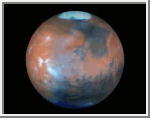|
COMETS EARTH JUPITER KUIPER BELT MARS MERCURY METEORITES NEPTUNE OORT CLOUD PLUTO SATURN SOLAR SYSTEM SPACE SUN URANUS VENUS ORDER PRINTS
PHOTO CATEGORIES SCIENCEVIEWS AMERICAN INDIAN AMPHIBIANS BIRDS BUGS FINE ART FOSSILS THE ISLANDS HISTORICAL PHOTOS MAMMALS OTHER PARKS PLANTS RELIGIOUS REPTILES SCIENCEVIEWS PRINTS
|
Related Document
Download Options
"The weather on Mars: another cool and clear day. Low morning haze will give way to a mostly sunny afternoon with high clouds. The forecast for Venus: hot, overcast, sulfuric acid showers will continue. Air quality is slightly improved as smog levels subside." NASA's Hubble Space Telescope is serving as an interplanetary weather satellite for studying the climate on Earth's neighboring worlds, Mars and Venus. To the surprise of researchers, Hubble is showing that the Martian climate has changed considerably since the unmanned Viking spacecraft visited Mars in the mid-1970s, which was the last time astronomers got a close-up look at weather on the Red Planet for more than just a few months. Hubble images of fleecy clouds, and spectroscopic detection of an ozone abundance in Mars' atmosphere, all indicate that the planet is cooler, clearer and drier than a couple of decades ago. In striking contrast, Hubble's spectroscopic observations of Venus show that the atmosphere continues to recover from an intense bout of sulfuric "acid rain" triggered by the suspected eruption of a volcano in the late 1970s. This is similar to what happens on Earth when sulfur dioxide emissions from coal power plants are broken apart in the atmosphere to make acid rain. On Venus, this effect takes place on a planetary scale. Although the close-up visits by numerous unmanned spacecraft provided brief snapshot glimpses of weather on these planets, the long-term coverage offered by Hubble has never before been possible. Knowledge about the weather is critical to planning future missions to these worlds. In the case of Mars, being able to predict the weather will be critical prior to human exploration and, perhaps eventually, colonization. Studying conditions on Mars and Venus might also lead to a better understanding of Earth's weather system. Apparently, processes that occurred early in the solar system's history sent terrestrial planets along very different evolutionary paths. The neighboring planets are grand natural laboratories for testing computer models that will lead to a general theory of the behavior of planetary atmospheres.
Don Savage
NASA Headquarters, Washington, DC
(Phone: 202-358-1547) EMBARGOED UNTIL: 2:00 P.M. EST
March 21, 1995
Tammy Jones
Goddard Space Flight Center, Greenbelt, MD
(Phone: 301-286-5566)
Ray Villard RELEASE NO: STScI-PR95-16
Space Telescope Science Institute, Baltimore, MD
(Phone: 410-338-4514)
|
